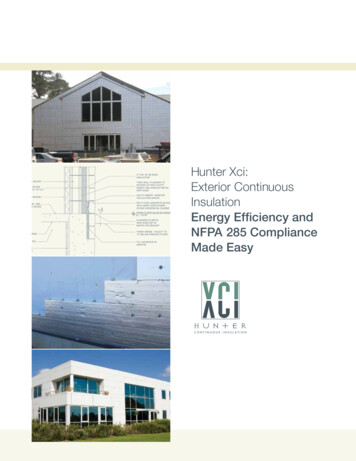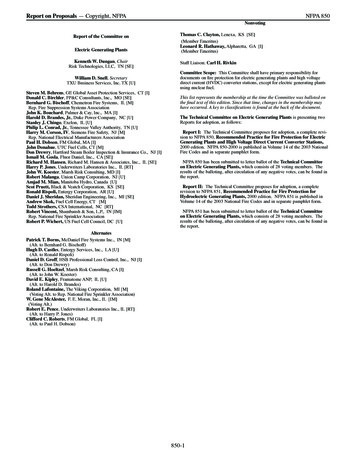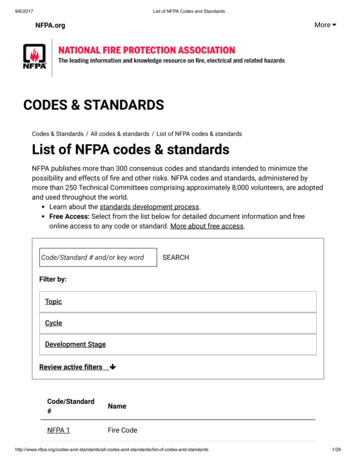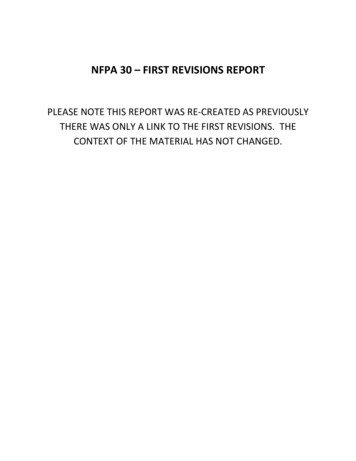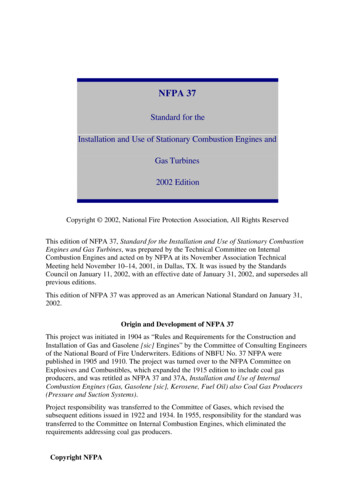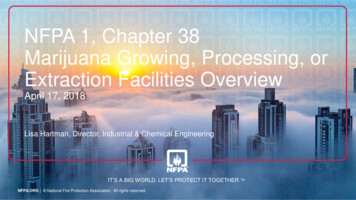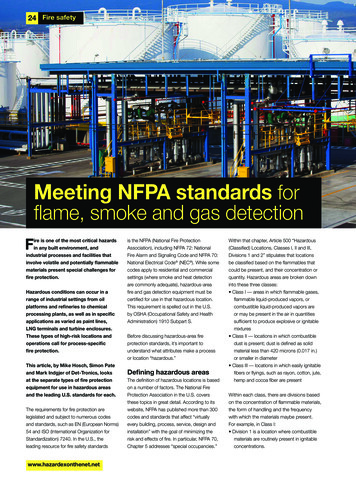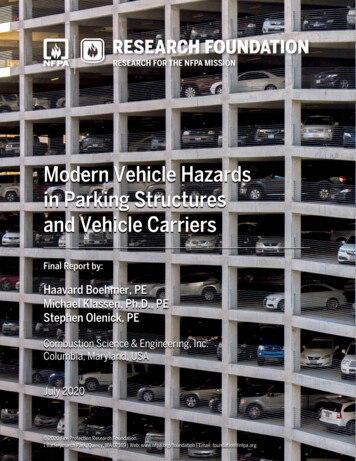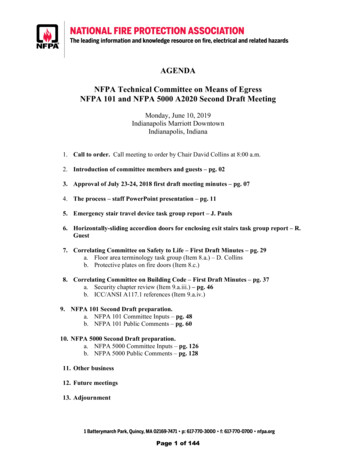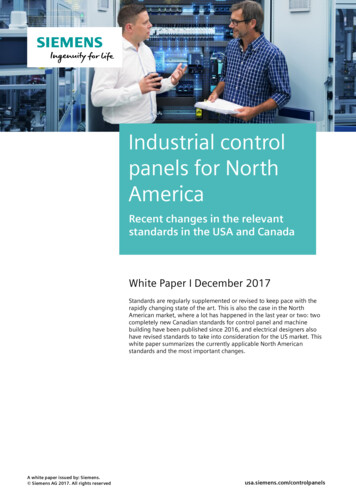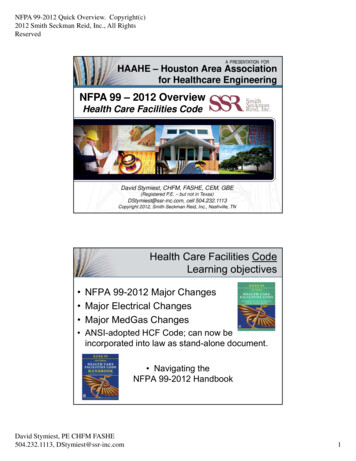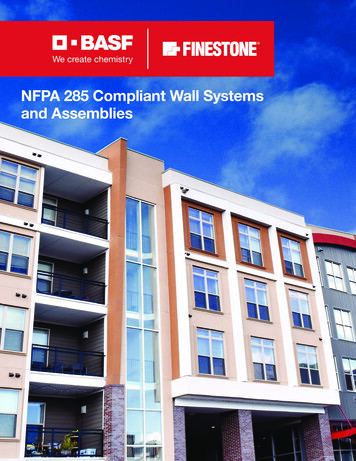
Transcription
NFPA 285 Compliant Wall Systemsand Assemblies
2Solutions forNon-combustible ConstructionCreating non-combustible exterior wall assemblies has become increasingly challenging as buildingdesign has evolved toward greater levels of energy efficiency. To meet the requirements of theInternational Energy Conservation Code, buildings have incorporated air/water-resistive barrierson exterior sheathing and CMU walls, together with extensive use of exterior insulation. In additionto improving energy efficiency, these changes can provide effective moisture management byincorporating an airtight secondary drainage plane, and by moving the dew point of the wall assemblyoutside of the drainage plane.
3However, both the air/water-resistive barrier and many types of exterior insulation are made fromorganic materials that are combustible. One challenge for design professionals is to incorporatecombustible materials into noncombustible construction in a way that reliably provides the fireperformance required by the International Building Code.Finestone Pebbletex CI-DCA, Pebbletex CI-DCA with MaxGrip Veneer Mortar, Pebbletex PlatinumCI and Platinum CI Stucco Ultra Wall Systems have been comprehensively qualified for use in noncombustible construction. When installed per BASF details and instructions, they provide codecompliant fire performance as listed on system brochures. This extensive set of performance data issteadily updated as local and national fire standards evolve.Finestone Wall Systems provide code compliant performance.
4Finestone specialty finishes are available in brick, stone, metal, and stucco motifs. Dynamic aesthetics combined with continuous exterior insulation anda monolithic air/water-resistive barrier create impressive lightweight, high-performance building enclosures.Wall AssembliesWall assemblies are a collection of products from more than one manufacturer that collectively functionas a wall cladding. Insulation, exterior skin, air barrier, water-resistive barrier, fasteners, lintels, furringand other components come together to form a wall assembly.FINESTOP air/water-resistive barriers are fluid-applied systems that are supported with ICC-ESR 2986,which confirms code compliance in Type I – V construction. FINESTOP systems can be used to create acontinuous drainage plane and air barrier system as part of a wall assembly design.Finestone CI Wall SystemsFinestone CI Wall Systems presented in this guide incorporate a FINESTOP air/water-resistivebarrier, continuous exterior insulation and an outer skin that can be finished to create a broad rangeof appearances. These systems meet the full range of International Building Code and InternationalEnergy Conservation Code requirements, and are supported with third-party test data, architecturaldetails and system warranties. Utilizing Finestone CI Wall Systems provides a simplified approach towall cladding design.
5Solutions for Buildings with Multiple CladdingsWhere buildings employ multiple claddings, FINESTOP air/water-resistive barriers can be extendedbeyond Finestone wall systems, and provide NFPA 285 compliant performance as part of wallassemblies that utilize materials from multiple manufacturers.Although not related to fire performance,airtightness and secondary water drainage arekey building considerations. Use of a continuous,monolithic air/water-resistive barrier, suppliedby a single manufacturer, is a recognized way toimprove air tightness and moisture management.It also helps integrate multiple claddingassemblies into an overall building enclosure.FINESTOP RA, FINESTOP RS, and FINESTOP VBare supported with extensive NFPA 285 datacovering a wide range of wall assembly options.This allows design professionals to specifyFINESTOP products behind multiple claddingsused alone or in conjunction with Finestone WallSystems.Claddings that are comprised of materialsfrom more than one manufacturer require carefulFinestop air/water-resistive barriers can provide a continuousair and water-resistive barrier behind multiple claddings foruninterrupted air and moisture protectionconsideration. Some fire requirements, such as theASTM E84 Steiner Tunnel test, apply to specific materials. Others, such as NFPA 285, are assemblytests where the assembly itself must be evaluated.NFPA 285 Compliant Wall Systems and AssembliesThe components listed in the following sections – Base Wall System (Section A), Air/Water-ResistiveBarrier (Section B), Exterior Insulation (Section C), and Exterior Cladding (Section D) can be combinedto create wall systems and assemblies that comply with NFPA 285 requirements.
6SECTION A: Base Wall System1. Concrete Wall2. Concrete Masonry Wall3. Steel Stud Framed Wall:Minimum 20-gauge 3-5/8 inch studs, with lateral bracingevery 4 feet vertically (maximum 24” O.C.)a. Interior wallboard: minimum 1 layer of 1/2” or 5/8-inch Type Xgypsum wallboard on interior face of studsb. Interior vapor barrier (optional) 1 layer of maximum 6-milpolyethylene plasticc. Cavity insulation: None or any noncombustible insulation(faced or unfaced)d. Floorline firestopping: 4 lb/cu foot mineral wool (e.g. Thermafiber )in each stud cavity and at each floorline, attached with Z-clips orequivalente. Exterior sheathing: 1/2-inch or 5/8-inch thick exterior gradegypsum sheathing4. Podium Wall:3-5/8 inch Fire Retardant Treated (FRT) lumber studs,spaced 16” or 24” O.C., with lateral bracing every 4 feetvertically (maximum 24” O.C.) Openings may be lined with1.5” FRT lumber.NOTE: Qualified for use with Finestone CI and CIStucco systems only.a. Interior wallboard: minimum 1 layer of 1/2-inch or 5/8-inch Type Xgypsum wallboard on interior face of studsb. Interior vapor barrier (optional) 1 layer of maximum 6-milpolyethylene plasticc. Cavity insulation: None or any noncombustible insulation(faced or unfaced)d. Floorline firestopping: 4 lb/cu foot mineral wool (e.g. Thermafiber )in each stud cavity and at each floorline, attached with Z-clips orequivalente. Exterior sheathing: 1/2-inch or 5/8-inch thick exterior gradegypsum sheathing; FRT Plywood or LP Flameblock (2-sided)SECTION B: Air/Water-Resistive Barrier1. Finestop RA or Finestop RSVapor permeable barriersWith 4” BASF SHEATHING FABRIC reinforcement or 20-mils BASFMAXFLASH Liquid Flashing Membrane at sheathing joints2. Finestop VBClass 1 vapor retarderWith 4” BASF SHEATHING FABRIC reinforcement or 20-mils BASFMAXFLASH Liquid Flashing Membrane at sheathing jointsSECTION C: Exterior Insulation Selections for Wall Assemblieswith Finestop Air/Water- Resistive Barriers1. None2. Any unfaced noncombustible insulation(e.g. mineral wool)3. Expanded Polystyrene Foam (EPS)a.b.c.Maximum 2.4-inch BASF NEOPOR GPS Plus Type II RigidInsulation BoardMaximum 2.5-inch thickness ASTM C578 Type II EPS(must be ASTM E84 Class A)Maximum 1.8-inch thickness ASTM C578 Type IX EPS(must be ASTM E84 Class A)4. Extruded Polystyrene Foam (XPS)Maximum 3-inch thickness, ASTM C578 Type IV or Type X(must be ASTM E84 Class A)5. Polyisocyanurate Foama.b.c.d.e.f.Maximum 4-inch thickness, Atlas EnergyShield ProMaximum 4-inch thickness, Atlas EnergyShield Pro2Maximum 3-1/2-inch thickness, Hunter Xci Class AMaximum 3-1/2-inch thickness, Hunter Xci CGMaximum 4-1/4-inch thickness, Hunter Xci Ply(maximum 3-1/2-inch thickness foam, maximum 3/4 inch plywood)Maximum 3-1/2-inch thickness, Carlisle R-2 Sheathe, R2 Mat orR2 Silver
7SECTION D: Finestone Exterior Cladding Systems1. Pebbletex CI-DCAa. Maximum 12-inch thickness ASTM C578 Type I EPS (must be ASTM E84)*b. Maximum 4-inch thickness ASTM C578 Type I EPS (must be ASTM E84)* withMAXGRIP VENEER MORTAR and adhered veneer (eg. thin brick, stone, tile)* EPS insulation used in Pebbletex CI-DCA must meet Finestone specifications2. Platinum CIa. Maximum 12-inch thickness NEOPOR GPS Type I Rigid Insulation Boardb. Maximum 7.8-inch thickness NEOPOR GPS PLUS Type II Rigid InsulationBoard** Neopor insulation used in Platinum CI must meet Finestone specifications3. Platinum CI Stucco Ultraa.b.c.d.e.f.g.h.i.j.k.Maximum 2.5-inch thickness of ASTM C578 Type II EPS (must be ASTM E84Class A)Maximum 2.4-inch thickness NEOPOR GPS PLUS Type II Rigid InsulationBoardMaximum 3-inch thickness of ASTM C578 Type XI EPS (must be ASTM E84Class A)Maximum 1.7-inch thickness of ASTM C578 Type IX EPS (must be ASTM E84Class A)Maximum 3-inch thickness XPS, ASTM C578 Type IV or Type X (must beASTM E84 Class A)Maximum 3-inch thickness, Atlas EnergyShield ProMaximum 3-inch thickness, Atlas EnergyShield Pro2Maximum 3-inch thickness, Hunter Xci Class AMaximum 3-inch thickness, Hunter Xci CGMaximum 4-1/4-inch thickness, Hunter Xci Ply (maximum 3-1/2-inch foam,maximum 3/4-inch plywood)Maximum 3-inch thickness, Carlisle R-2 Sheathe, R2 Mat or R2 SilverNOTE: Interior sheathing must be 5/8" type X gypsum wallboard for allCI Stucco systems
8SECTION D: Exterior CladdingWall Assemblies using Finestop Air/Water-Resistive Barriers3. Heavy and NoncombustibleCladding AssembliesThese systems are characterized by their high mass, inorganic compositionand noncombustible nature. All of the insulation systems listed inSection C can be used with the heavy cladding systems listed below.Interior gypsum sheathing must be 5/8” thick. Atlas polyisocyanurateinsulation also requires 5/8” thick exterior gypsum sheathing.Brick - Standard nominal 4” thick clay brick with standard brick veneeranchors installed maximum 24” on center vertically on each stud with amaximum 2” air gap between the brick and exterior insulation.Stucco – ASTM C926 three coat stucco, minimum 3/4” thick,Permalath 1000 or Metal Plaster Base per ASTM C1063, with paintor textured acrylic finish.Stone veneer - Minimum 2” thick limestone, natural stone or minimum1-1/2” thick cast artificial stone.Terra cotta - Minimum 1-1/4” thick non-open jointed. Any standardnon-open jointed installation technique can be used.Limestone or natural stone veneer - Minimum 2” thick (or minimum 1-1/2”thick) cast artificial stone installed using a standard installation technique.Concrete - Minimum 1-1/2” thick concrete masonry unit (CMU), precastconcrete or artificial cast stone. Any standard non-open jointed installationtechnique can be used.4. Metal Skin Noncombustible Exterior WallCovering using Steel or CopperAny standard installation technique can be used. Options listed in Section C1,C2 or C5 are acceptable (no insulation, noncombustible insulation orcertain polyisocyanurate insulation). Interior and gypsum sheathing mustbe 5/8” thick.5. Cement Board SidingAny standard installation technique can be used (maximum 2” air gap).Options listed in Section C1, C2, or C5 are acceptable (no insulation,noncombustible insulation or certain polyisocyanurate insulation).6. Metal Composite (MCM or ACM) PanelsUse any MCM or ACM panel that has passed NFPA 285 (maximum 2”air gap). Options listed in Section C1, C2, or C5 are acceptable (noinsulation, noncombustible insulation or certain polyisocyanurate insulation).Interior and gypsum sheathing must be 5/8” thick.7. Reynobond ZCM Zinc Alloy Composite PanelSystemAny standard installation technique can be used. Options listed in Section C1,C2, C5a, or C5b are acceptable (no insulation, noncombustible insulationor certain polyisocyanurate insulation). Interior and gypsum sheathing mustbe 5/8” thick.8. Autoclaved Aerated Concrete Panels thathave passed NFPA 285 criteriaOptions listed in Section C1, C2, C5a, or C5b are acceptable(no insulation, noncombustible insulation or certain polyisocyanurateinsulation). Interior and gypsum sheathing must be 5/8” thick.9. Stone/Aluminum honeycomb compositebuilding panels that have passed NFPA 285criteria.Any standard installation technique can be used. Options listed in Section C1,C2, C5a, or C5b are acceptable (no insulation, noncombustible insulationor certain polyisocyanurate insulation). Interior and gypsum sheathing mustbe 5/8” thick.
9Finestone Wall Systems can create a multiple cladding appearance with continuous exterior insulation and a seamless air/water-resistive barrierFinestop air/water-resistive barriers can provide seamless monolithic protection on buildings with multiple claddings
10Brick, granite, and cut stone are some of the popular appearances created by Finestone Wall Systems.Pebbletex CI-DCA, incorporating BASF Metallic Effects, can produce an energy efficient building with endless design possibilities.
11Finestone wall systems listed in this guide comply withNFPA 285 and NFPA 268 requirements, and use materialsthat provide ASTM E84 Class A performance. Please seethe respective system brochures for more information,or contact BASF Technical Support atwallsystemstechsupport@basf.com.Finestone CI details and guide specifications that areconsistent with the NFPA 285 performance listed in thisguide. These details and specifications are also consistentwith other relevant standards. Design professionals whospecify Finestone insulated wall systems installed perBASF Wall Systems instructions are specifying codecompliant systems.“Design professionalswho specify Finestone CIWall Systems installed perBASF instructions arespecifying codecompliant systems.“Thermal, Mechanical, WaterDrainage, and Fire Performanceof Finestone CI Wall SystemsMind the Details when SpecifyingNFPA 285 Compliant Wall AssembliesThe NFPA 285 compliant wall assemblies outlined in thisbrochure may be subject to additional fire performance andbuilding code requirements. Design professionals shouldensure that all relevant requirements are met.The wall assemblies listed in this section have beentested using specific termination detailing at the windowrough opening. These details vary by assembly. Designprofessionals should consult with the manufacturer of thespecific insulation and/or cladding materials listed in thisguide to obtain and specify relevant rough opening details.Failure to correctly detail rough openings will resultin wall assemblies that do not comply with NFPA 285requirements.Finestone Wall Systems are detailed in accordancewith prevailing code requirements
BASF Corporation - Wall Systems889 Valley Park DriveShakopee, Minnesota 55379Phone: 800.589.1336www.finestone.basf.com 2019 BASF Corporation45220725 rev 09/2019
Class A) b. Maximum 2.4-inch thickness NEOPOR GPS PLUS Type II Rigid Insulation Board c. Maximum 3-inch thickness of ASTM C578 Type XI EPS (must be ASTM E84 Class A) d. Maximum 1.7-inch thickness of ASTM C578 Type IX EPS (must be ASTM E84 Class A) e. Maximum 3-inch thickness XPS, ASTM C578 Type IV or Type X (must be ASTM E84 Class A) f.
